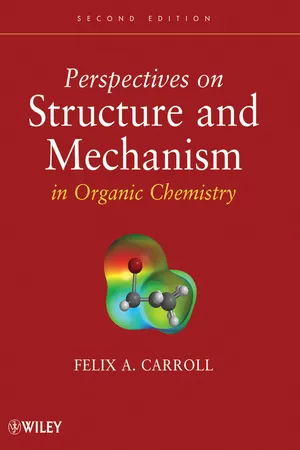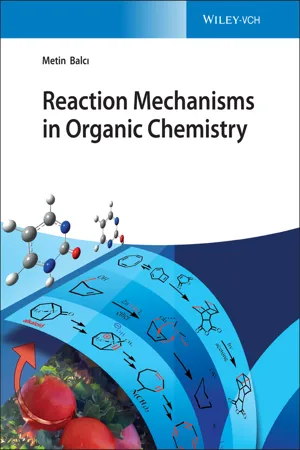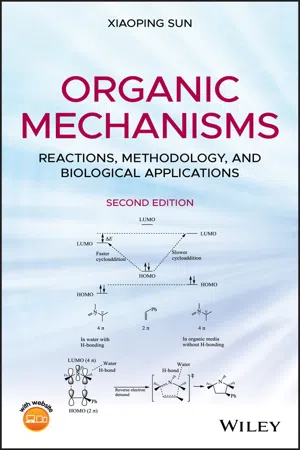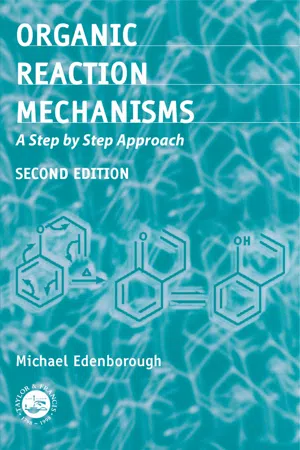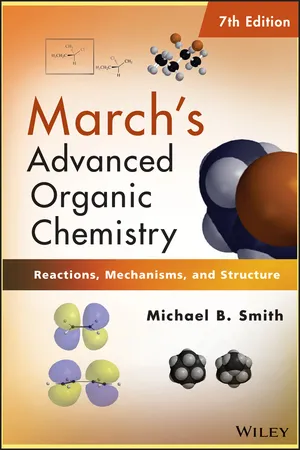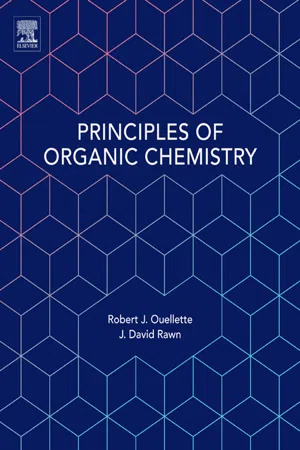Chemistry
E1cb Elimination
The E1cb elimination is a type of elimination reaction in organic chemistry that occurs in a single, concerted step. It involves the removal of a leaving group and a proton from adjacent carbon atoms, resulting in the formation of a double bond. The reaction is favored in polar, aprotic solvents and is often used in the synthesis of alkenes.
Written by Perlego with AI-assistance
Related key terms
Related key terms
1 of 4
Related key terms
1 of 3
6 Key excerpts on "E1cb Elimination"
- No longer available |Learn more
- Felix A. Carroll(Author)
- 2011(Publication Date)
- Wiley(Publisher)
‡ .The distinction between various mechanistic possibilities for 1,2-elimi-nation reactions is sometimes difficult, and more detailed investigations can reveal greater mechanistic complexity than we might assume. For example, there was a report that the elimination of HBr from 2-(4-nitrophenyl)ethyl bromide, the ‘‘classical E2 reaction’’ (equation 10.21 ), occurs instead by an E1cb mechanism (equation 10.22 ).35(10.21)(10.22)(10.23)De Angelis and co-workers found from experimental and theoretical studies that the E1cb and E2 paths seemed to ‘‘merge smoothly’’ into each other in the hydroxide-promoted elimination of HF from 2-(2-fluoroethyl)-1-methylpyridinium ion in aqueous solution (equation 10.23 ).36, 37 The potential energy surface in Figure 10.17 suggests that the energy barrier for fluoride loss decreases continually as the bond from carbon to the abstracted proton lengthens. As a result, the potential energy surface is nearly flat for C–H distances of ca. 1.8 Ǻ, and the carbanion intermediate can lose fluoride ‘‘ almost instantaneously.”37Competition Between Substitution and EliminationIt is an axiom of organic chemistry that substitution and elimination reactions are competitive processes.5 Elimination is generally favored at higher temperatures, while lower temperatures result in a higher percentage of substitution product in both E1 and E2 reactions. For example, in the solvolysis of t -butyl chloride in 80% aqueous ethanol, the percentage of isobutene increased from 16.8% to 36.3% as the temperature was increased from 25°C to 65°C.38– 39 The effect of temperature on the ratio of substitution to elimination in a 2° substrate was smaller: the percentage of elimination product from the reaction of 2-bromopropane with ethoxide in ethanol was 53% at 45°C and 57% at 75°C. These trends can be explained by the kinetic data for competition between SN 2 and E2 pathways for reactions of several substrates with sodium ethoxide (Table 10.1 ). Both E a and log A are seen to be greater for elimination than for substitution.38, 40 - eBook - ePub
- Metin Balc?, Metin Balc?, Metin Balc?, Metin Balc?, Metin Balc?(Authors)
- 2021(Publication Date)
- Wiley-VCH(Publisher)
Of course, higher cyclic systems can also be created depending on the position of the leaving groups in the molecule. In this section, we will only discuss 1,2-elimination (β-elimination) reactions because they are one of the most important methods applied to generate a double bond as alkenes are essential industrial compounds. The application area of these reactions is extensive and they are also mechanistically very important. Elimination can be described by the following three model mechanisms : E1 Elimination: unimolecula r elimination E2 Elimination: bimolecular elimination E1cb Elimination: conjugate base elimination 3.1 Unimolecular Elimination Reactions, E1 Nucleophilic substitution reactions of alkyl halides, tosylates, and similar groups were examined in detail in the previous section. In the S N 1 reaction, we have seen that nucleophiles readily trap a carbocation formed in the first step through an attack at the positively charged carbon atom. However, this is not the only mode of the reaction. If there is a base in the reaction medium, following the formation of the carbocation, the base can remove a proton from the adjacent carbon atom (β-carbon atom) to form a double bond. A base is needed for the elimination reaction given in the above equation. The base can also be weak. How can a weak base such as H 2 O remove a proton from an sp 3 -hybridized carbon atom (p K a > 50) ? When a carbocation is formed, the acidity of the proton attached to the adjacent carbon atom is increased because of the positive charge on the carbon atom and the p K a value is significantly reduced. Then, even a weak base can take the proton, forming a double bond between the carbon atoms bearing the departed groups. As seen from the example above, a common intermediate, a carbocation, is formed in both unimolecular substitution and unimolecular elimination reactions. This cation undergoes substitution or elimination reactions - eBook - ePub
Organic Mechanisms
Reactions, Methodology, and Biological Applications
- Xiaoping Sun(Author)
- 2020(Publication Date)
- Wiley(Publisher)
n + 2) rule and will be discussed in the chapter.Some special bases and their effectiveness in bringing about the elimination reactions are presented. Since many bases are nucleophilic, the E1 and particularly E2 reactions are often accompanied by nucleophilic substitutions. The competitions between elimination and nucleophilic substitution reactions which occur to the same functionalized compounds will be addressed.Elimination of LG1 /LG2 (two functional groups) on adjacent carbons (X, Y = LG1 , LG2 ) is of special interest in organic chemistry. The reaction can follow an anti‐elimination mechanism (with a staggered conformation of the substrate and –LG1 and –LG2 being anti‐coplanar) or a syn‐elimination mechanism (with an eclipsed conformation of the substrate and –LG1 and –LG2 being syn‐coplanar). Both the mechanistic pathways will receive detailed discussion in the chapter.The α‐elimination (Eq. 7.2 ), in which an H–LG unit (X, Y = H, LG) or two functional groups (X, Y = LG1 , LG2 ) is eliminated from a single carbon giving a carbene, is another important type of elimination reactions.(7.2)Symmetry analysis and theoretical studies using the MO model for the α‐elimination are presented in the chapter. The mechanism for the related rearrangement of carbenes to alkenes via a C─H bond elimination will be discussed.Electronegative group facilitated E1cb reactions also possess important synthetic utility and mechanistic significance. They will be presented as well. Elimination reactions have found many applications in biological systems. In this chapter, mechanisms for a few selected enzyme‐catalyzed biological eliminations are reviewed. - eBook - ePub
Organic Reaction Mechanisms
A Step by Step Approach, Second Edition
- Michael Edenborough(Author)
- 2017(Publication Date)
- CRC Press(Publisher)
N 1 reactions often compete with each other. In the normal El mechanism, the heteroatom leaves first to form the carbonium ion intermediate. However, if the hydrogen leaves first, then this would result in a carbanion being formed. This reaction type is called the ElcB mechanism, which stands for unimolecular elimination conjugate base reaction. An example would be the reverse of a Michael addition reaction. Furthermore, a poor nucleofuge favours an ElcB reaction pathway, e.g. in the reverse of the cyanohydrin formation reaction.The El, E2 and ElcB mechanisms are all closely related. In all of these mechanisms, one group leaves with its electron pair (the nucleofuge), while the other group, which is often a proton, leaves without its electron pair. In the El mechanism, the nucleofuge leaves first; while in the ElcB, the proton leaves first, and thereafter the nucleofuge. In the E2 mechanism, the two groups depart simultaneously. All−M groups, such as carbonyl, when adjacent to the hydrogen atom, or even −I groups, such as the halogens, favour the ElcB route; while +M groups, or even +1 groups like alkyl groups, disfavour this pathway.In ElcB reactions, there is usually little ambiguity as to the regiochemistry of the resultant compound, because normally there is only one site from which an acidic hydrogen may be removed as a proton. Thus, in El reactions, Zaitsev elimination is preferred. Both alkyl or aryl groups at the α-carbon favour the El pathway. Further, generally, the more branching in the carbon chain, the more elimination occurs, because of the increased importance of alleviating steric strain.The addition of an external base alters the reaction pathway to an E2 mechanism. At a low concentration of a weak base, the unimolecular pathway is favoured, so long as the solvent is ionising. Under these conditions substitution is favoured over elimination. The better the leaving group, the more the El pathway is favoured. Synthetically, the most important leaving group is the H2 O molecule. If the nucleofuge is Cl− , Br− , I− or NR3 - No longer available |Learn more
March's Advanced Organic Chemistry
Reactions, Mechanisms, and Structure
- Michael B. Smith(Author)
- 2013(Publication Date)
- Wiley(Publisher)
10617.D. Reactivity
In this section, we examine the effects of changes in the substrate, base, leaving group, and medium on (1) overall reactivity, (2) E1 versus E2 versus E1cB,107 and (3) elimination versus substitution.17.D.i. Effect of Substrate Structure
1. Effect on Reactivity. The carbon containing the nucleofuge (X) is referred to as the α carbon and the carbon that loses the positive species (usually a proton) as the β carbon. Groups attached to the α or β carbons can exert at least four kinds of influence:a. They can stabilize or destabilize the incipient double bond (both α and β groups).b. They can stabilize or destabilize an incipient negative charge, affecting the acidity of the proton (β groups only).c. They can stabilize or destabilize an incipient positive charge (α groups only).d. They can exert steric effects (e.g., eclipsing effects) (both α and β groups).Effects a and d can apply in all three mechanisms, although steric effects are greatest for the E2 mechanism. Effect b does not apply in the E1 mechanism, and effect c does not apply in the E1cB mechanism. Groups such as Ar and C=C increase the rate by any mechanism, except perhaps when formation of the C=C bond is not the rate-determining step, whether they are α or β (effect a). Electron-withdrawing groups increase the acidity when in the β position, but have little effect in the a position unless they also conjugate with the double bond. Thus Br, Cl, CN, Ts, NO2 , CN, and SR in the β position all increase the rate of E2 eliminations.2. Effect on E1 versus E2 versus E1cB. The α alkyl and α aryl groups stabilize the carbocation character of the transition state, shifting the spectrum toward the E1 end. β Alkyl groups also shift the mechanism toward E1, since they decrease the acidity of the hydrogen. However, β aryl groups shift the mechanism the other way (toward E1cB) by stabilizing the carbanion. Indeed, as seen in Section 17.A.iii, all electron-withdrawing groups in the β position shift the mechanism toward E1cB.108 - eBook - ePub
- Robert J. Ouellette, J. David Rawn(Authors)
- 2015(Publication Date)
- Elsevier(Publisher)
N 2 reaction mechanism, the E2 mechanism is a concerted process. In an E2 dehydrohalogenation reaction, the base (nucleophile) removes a proton on the carbon atom adjacent to the carbon atom containing the leaving group. As the proton is removed, the leaving group departs and a double bond forms.Like the SN 2 reaction, an E2 reaction requires a precise molecular arrangement. The anticonformation of the hydrogen and halogen atoms is preferred for the reaction because it aligns the orbitals properly for the formation of the π bond. We can visualize the process as the removal of the proton to provide an electron pair that attacks the neighboring carbon atom from the back to displace the leaving group. An E2 reaction occurs at a rate that depends on the concentrations of both the substrate and the base. If the substrate concentration is doubled, the reaction rate also doubles, as in SN 2 processes. Thus, both E2 and SN 2 mechanisms are affected in the same way, and the two mechanisms compete with each other.The E1 Mechanism
We recall that an SN 1 reaction proceeds in two steps, and that the rate-determining step is formation of a carbocation intermediate. Similarly, an E1 mechanism occurs in two steps, and the rate-determining step is the formation of a carbocation. Thus, just as E2 and SN 2 mechanisms compete with each other, an E1 mechanism competes with an SN 1 mechanism. Because the rate-determining step of an E1 reaction involves only the substrate, the formation of the carbocation is a unimolecular reaction. If the carbocation reacts with a nucleophile at the positively charged carbon atom, the result is substitution. But if the nucleophile acts as a base and removes a proton from the carbon atom adjacent to the cationic center, the net result in the loss of HL and the formation of a π bond—that is, an elimination reaction.7.7 Effect of Structure on Competing Reactions
Let’s now examine the variety of product mixtures that result from competing substitution and elimination processes. We will divide our discussion according to the type of haloalkane. These results are summarized in Table 7.2
Index pages curate the most relevant extracts from our library of academic textbooks. They’ve been created using an in-house natural language model (NLM), each adding context and meaning to key research topics.
Explore more topic indexes
Explore more topic indexes
1 of 6
Explore more topic indexes
1 of 4
